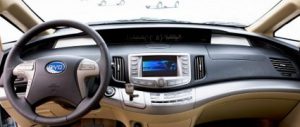Beijing used to be famous for the millions of bicycles thronging its streets. But it is the success of the motor car there and in other Chinese mega-cities that has now tipped the number of cars in the world over the one-billion mark.
According to a report by the trade journal Ward’s, 35 million new cars and trucks were sold worldwide last year – the second-biggest increase ever recorded. That is 95,500 extra vehicles being added to the global traffic jam every day.
Almost half of the new growth is in China, which recently overtook the United States as the world’s biggest car market thanks to the sales of 13.8 million new passenger vehicles. Despite the surge in sales, car ownership in China is still only half the global average.
But hopes that the country will also become a pioneer in the shift towards “clean car” technology have suffered a setback as the Chinese show little sign of interest in electric and hybrid vehicles despite ambitious government plans. Sports utility vehicle (SUV) sales, by contrast, are surging.
This is not just affecting foreign companies such as Toyota. It had been hoped that government subsidies and policy support would help China’s manufacturers, such as BYD, to leapfrog better-established overseas rivals by mass-producing electric cars.
But BYD has scaled back its ambitions after failing to find a market because of costs, safety concerns and underdeveloped battery technology. Reflecting the lack of progress, Prime minister Wen Jiabao recently published an article in a Communist party journal calling for a rethink of China’s “road map” towards alternative powertrain vehicles – those that do not rely only on a conventional internal combustion engine.
In a report in August, IHS Automotive, a Shanghai-based consultancy, said the take-up for such vehicles was far behind the government’s time-frame. It noted, too, the lack of interest in Toyota’s Prius, which has witnessed sales in China fall from about 200 in 2009 to – according to some reports – just one in 2010. It is not known who made that supposed solitary purchase; industry analysts said it was unlikely to be an individual as there is little technical support for the model. “It may be a domestic rival that bought the hybrid to strip it down and see how it works,” said one industry observer who did not want to be named.
Among registrations of new passenger cars were 850,000 SUVs – a rise of 24% – including 425 Hummers. Since then car sales have flattened but the luxury sector is still surging.
Thanks largely to its business in China, Mercedes announced earlier this year the highest monthly worldwide car sales in the company’s 110-year history. BMW, Audi and Rolls-Royce are also recording strong sales which have pushed China to the forefront of their global strategies.
This runs directly opposite to the government’s stated goal of creating a more equal, environmentally friendly nation, suggesting a change of strategy may be needed. The state is unlikely to completely abandon its promotion of “clean” car technology, but it may have to revise its plans.
The government’s current aim is to put one million “new energy” vehicles on the roads by 2015 – electrics and plug-in hybrids – but this now looks overambitious. Despite subsidies of 60,000 yuan (US$9,400) for pure electric vehicles and 50,000 yuan (US$7,800) for plug-in hybrids in five pilot cities, there have been few buyers because regular cars are still cheaper and more reliable.
According to IHS Automotive, electric vehicles sales are unlikely to reach a tenth of the state’s target over the next five years. Rather than jump directly to electric cars, it now expects bureaucrats to pay more attention to hybrid cars and fuel-efficient conventional vehicles. Although “in the long term pure [electric vehicles] may still become mainstream, it is welcome to see the government slowly but surely recognising that its targets are inflated,” IHS noted.
Many are still betting on the Chinese market. GreenTech Automotive of the United States recently announced a venture with Shengyang ZhongRui to create a plant in Inner Mongolia with capacity to build 300,000 electric and hybrid cars a year.
From 2000 to 2010, the number of cars and motorcycles in China increased twentyfold. In the next 20 years it is forecast to more than double again, which means there will be more cars in China in 2030 than there were in the entire world in 2000.
The big brands argue that there is room for growth. Only one in 16 Chinese people owns a car, which is less than half the global average. If the country were to match the three-in-four ownership levels of the US, that would mean an extra 900 million vehicles.
Given the frequent traffic congestion and smog even at current levels, it is hard to imagine that ever happening. Even if all the new cars were hybrid or electric, the congestion would be incredible. Beijing has already begun restricting new licence registrations. Sales have flattened.
“Green growth” now looks a less likely prospect than a simple market slowdown.
https://www.guardian.co.uk/
Copyright © Guardian News and Media Limited 2011
Homepage image from shutterstock.com





